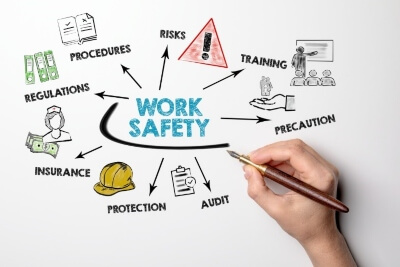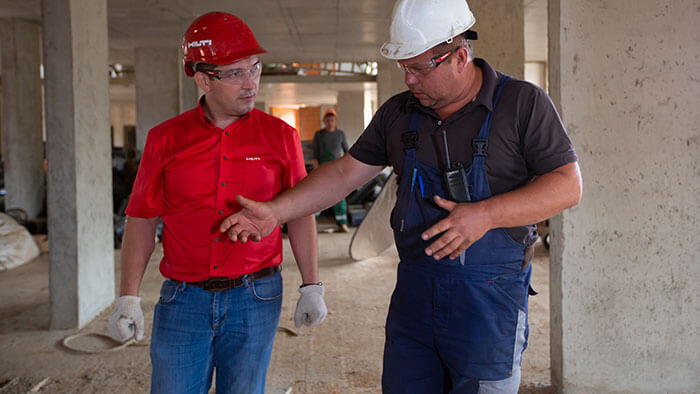Being a worker member of the JHSC has many obligations found in the Occupation Health and Safety Act, from hazard identification to control recommendations. In the last post, we covered workplace inspections – a proactive approach to hazard control in the workplace; but hindsight is 20/20, and on occasion some things are missed. Accident/Incident investigations are reactive; it is how issues that have caused problems in the past are addressed, so they do not happen again!

Now as a trainer, one of the first questions I get asked is one of clarification: What is an accident? What is an incident? These terms are mostly used interchangeably, as the event that prompts our investigations – but there is a difference.
An accident is what happens when a series of events outside of our control lead to injury or property damage. An incident is when something happens due to a breakdown of our current controls – in essence there is some internal blame or responsibility that can be found. With many of the Ministry of Labour publications stating that “all if not most injuries are preventable, there is no reason to have an incident in your workplace” – it can be determined that what occurs, in the eyes of the governing body, are in fact workplace incidents.
Whatever term your organization uses (accident vs incident) to describe the event, is not the purpose of this post – we are here to talk about investigations.
So, what is accident investigation? It is the process by which the cause of an accident is identified through evidence or assumption, and corrective measures are put in place. Let’s expand on that thought.
First, we need to clarify how to conduct the investigation. This is done with preparation. As a committee, you should have predetermined the steps you will follow to ensure that your investigation is consistent and thorough. As a basic framework, it should consist of the following: Secure the Scene, Collecting Information, Scene Assessment, Identify Contributing Factors, Determine Root Cause, Recommend Controls through the R.A.C.E. Methodology (Recognize, Assess, Control and Evaluation), and Create Accountability for Follow-up.
Secure the Scene
An often overlooked step, securing the scene is about preserving evidence. If someone is injured, administering first aid is usually what most people are concerned with. As an accident investigator, that is generally outside of your scope. Others will attend to the injured worker; you must preserve the integrity of your evidence. The conclusions drawn from the raw data will be incorrect if you are working with corrupted information. Stop work in the immediate area, post a worker to keep others away, caution tape and pylons can be used as well. Do not impede the rescue, but document any change in the scene as they happen.
Collect Information
In the event there is a workplace injury, the next step for the investigation is to collect and document as much information as possible. The information to collect will be specific to each situation, but generally the JHSC committee should begin by interviewing witnesses.
Eyewitness accounts are valuable because they can identify deviations from standard procedures, what controls (guards, tools, and equipment) were being utilized or not. They can speak to the psychological atmosphere of the work environment and give the investigator, who might not necessarily be a subject matter expert in that area of operations, an understanding of precisely what happened, versus what lead to an injury occurring. These interviews should be conducted as soon as possible after the event, and have the witnesses isolated from each other. The last thing you want is one cohesive story from all involved if they have had time to discuss and process the event into their memories. It is essential for the investigator to document all information provided.
This is not the stage for making conclusions; we are still collecting raw data for later use. If cameras are present, review those recordings as well.
Scene Assessment
Depending on the severity of the injury, the Ministry of Labour (MOL) Inspector could be present on site. If that is the case, the investigator will have to wait until the area is released into their control (perfect time to interview witnesses if permitted). Once the JHSC has access to the area, it is time to conduct a scene assessment. This is where the physical evidence will be recorded.
Things to document include position of the injured worker, position of any existing guards, use of chemicals, storage of materials compared to company policy, housekeeping of the area, lighting, temperature, noise levels, equipment being used, etc. By collecting and documenting this information it will allow for a sequence of events to be reconstructed. Take photographs to review after cleanup has occurred; ideally you would want multiple sets of photographs. One right at the time of injury to get the environment in its initial state, and another once the scene has been released to you as the investigator.
Identify Contributing Factors – People, Equipment, Materials, Environment, Process
At this point in the investigation, you should have a fair amount of raw data recorded. The next step is to start to process the information into what we call immediate causes. An immediate cause of an accident is otherwise known as a contributing factor. They are part of the chain of events leading to injury, but not what set it off – that would be a root cause.
The contributing factors are broken down into five categories – People, Equipment, Materials, Environment, and Process.
Understanding how these factors can worsen current existing hazards and render their control less effective will give the investigator a deeper or more thorough understanding of the sequence of events that lead to injury or property damage. Examples are as follows:
- People – consist of untrained or inexperienced workers, workers with an indifferent attitude, physical or mental health issues, drugs or alcohol.
- Equipment – preventative maintenance suited for where it is being used, owned or rented, performance characteristics, suited for the user.
- Materials – easy or difficult to handle, tipping/collapsing, large or bulky, blocking vision, individual vs team lifts.
- Environment – space availability, congestion, lighting/noise, ground conditions, indoor vs outdoor work, variability of the workplace, psychological atmosphere.
- Process – pace of work, frequency of tasks, complexity of the work, safety culture.
Once all of the contributing factors have been considered, then you as the investigator can take the data found in its raw form and create a realistic sequence of events based on the evidence. At this stage it is still important not to place blame, get sidetracked, or prematurely draw conclusions. What you are left with is a clear and logically based map towards the root cause.

Determine Root Cause
When reading CSA Z-1000, the importance of a proper root cause analysis is fundamental to the prevention of future workplace accidents. The root cause is what started the chain of events that lead to injury. For example, we have a puddle on the floor where a worker slipped. The puddle is nothing more than a contributing factor. We have to find out how that puddle came to be on the floor. Well, there is a housekeeping plan stating it should have been cleaned – still a contributing factor. Where did the puddle come from? A leak in the roof. The next question should be addressing how the leak came to be.
Root causes can include but are not limited to: inadequate policy, standards, or lack of legislative compliance on the part of management, lack of supervisory performance, inadequate purchasing or deviations from industry standards. The purpose of any investigation should be to determine the root cause of the accident. Once this inference has been verified by evidence, controls must be put in place. If the exact root cause is not isolated, then the organization will be correcting the wrong hazard – as a result injury can reoccur.
Recommend Controls through R.A.C.E. Methodology
At this stage of the investigation, the hardest part is done. You have used the case of injury or property damage to identify a previously unrecognized hazard in your organization. As any member of the JHSC knows, they are there to spot hazards and make recommendations. This is done by utilizing the RACE methodology. First, a hazard is recognized – an unknown hazard cannot be controlled. The assessment follows, what is the risk to the worker of a repeat injury. The assessment also includes looking for compliance issues and determining what the OHSA and regulations have in place regarding this hazard.
Once that has been completed, the investigator needs to work through the hierarchy of controls: elimination, substitution, engineering, administrative, and personal protective equipment. The control selected will be recommended to the employer to control the hazard identified by the investigation. Lastly, evaluation – is this hazard only present in one area of the workplace, or did we identify other areas where this issue is present. The purpose of an investigation is to recommend controls, like any other function of the JHSC.
Create Accountability for Follow-up
As a worker, and specifically a trainer, I have seen what commonly happens after a workplace injury and subsequent investigation. Safety becomes a flavour of the month. Creating accountability and a schedule for follow up ensures that even though the impact of the incident has passed into memory, the lessons learned are maintained. Incorporating the recommended controls into the JHSC worker member monthly inspection, or the supervisor’s daily safety check are all tools that can be implemented. Realistically, an effective workplace safety culture is developed by being constantly aware of previous incidents, and as a result the importance of the continued commitment to preventing them will become ingrained into that culture.
How do you write an accident investigation report?
The above information should provide you with the steps needed to conduct an effective workplace inspection, but how should it be presented? Due diligence dictates we need to document everything we do so in a report. Now there is no right or wrong way of writing an accident report provided it covers all of the details previously mentioned. I have worked for multiple organizations that had different templates and styles required as per the terms of reference of the committee.
Realistically a report is just a record of – what happened, how did it occur, what were the immediate causes, and what is the root cause. Once the root cause has been identified, it should assess, control, and evaluate the hazard. Remember, this report can end up as evidence in a courtroom one day. The report should be professional and well organized. If the report template your organization reflects what was covered in this post, I would say your committee is doing very well in establishing credibility to your workplace.
FREE RESOURCE:
Geoff Rowatt | CHRP | Safety Trainer






